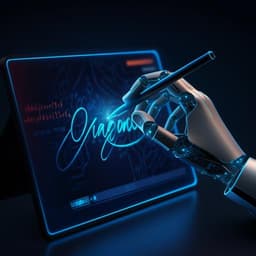
Computer Science
Predicting discrete-time bifurcations with deep learning
T. M. Bury, D. Dylewsky, et al.
This groundbreaking study reveals how deep learning classifiers can provide early warning signals for critical transitions in natural and man-made systems. By accurately predicting various bifurcation types, including period-doubling and fold bifurcations, the research offers a new frontier in monitoring critical dynamics. Conducted by Thomas M. Bury, Daniel Dylewsky, Chris T. Bauch, Madhur Anand, Leon Glass, Alvin Shrier, and Gil Bub.
~3 min • Beginner • English
Introduction
The study addresses how to predict critical transitions in systems that evolve in discrete time, where abrupt changes in dynamics occur as parameters cross bifurcation thresholds. Traditional early warning signals (EWS)—such as increases in variance and changes in lag-1 autocorrelation due to critical slowing down—have been observed across domains but have limited ability to discern the type of impending bifurcation and can fail in nonsmooth or noise-driven contexts. Prior deep learning approaches have been trained primarily on continuous-time bifurcations. This work targets the gap by developing a deep learning classifier to provide early warning signals specifically for discrete-time, codimension-one, local bifurcations and to identify the type of bifurcation. The purpose is to improve sensitivity, specificity, and informational content of EWS, with applications illustrated in ecology, physiology (including cardiac alternans), and economics.
Literature Review
The paper situates its contribution within bifurcation theory and EWS research showing critical slowing down manifests as trends in variance and autocorrelation before transitions. Analytical approximations exist for these indicators near bifurcations, and empirical observations have been reported in climate, geological, ecological, and cardiac systems. However, standard indicators often cannot identify the bifurcation type and may fail under nonsmooth potentials or noise-induced transitions. Recent work has used deep learning to provide EWS for bifurcations, successfully predicting continuous-time transitions and demonstrating generalization from simulated training libraries. Nonetheless, discrete-time systems can exhibit dynamics (e.g., period-doubling, Neimark–Sacker, chaos) not captured by continuous-time models, motivating specialized tools for discrete-time bifurcations. The authors focus on five local, codimension-one discrete-time bifurcations and build on prior deep-learning EWS efforts by creating a classifier trained on normal-form-based simulated data.
Methodology
Training data: The authors generate a library of 50,000 models (10,000 per bifurcation type: period-doubling, Neimark–Sacker, fold, transcritical, pitchfork). Each model consists of the normal form with higher-order polynomial terms up to degree 10 (coefficients ∼ N(0,1)) and additive Gaussian white noise with amplitude drawn from a uniform distribution. Bifurcations occur at μ = 0. For each model, a forced simulation increases μ linearly from μ0 to 0 and a null simulation fixes μ at μ0, where μ0 is drawn so that |λ| < 0.8 (λ is the Jacobian eigenvalue), ensuring a range of distances to bifurcation. After burn-in of 100 steps, 600 iterations are run and the last 500 points are kept, or the 500 points preceding a transition (defined as deviation from equilibrium exceeding 10σ). From 50,000 forced and 50,000 null runs, 10,000 null are sampled to balance classes, yielding 60,000 entries.
Classifier architecture and training: A CNN-LSTM network (as in ref. 25) is used: one convolutional layer with max pooling, two LSTM layers with dropout, and a dense output over six classes (null + five bifurcations). Adam optimizer (lr=0.0005), batch size 1024, sparse categorical cross-entropy loss, 200 epochs, and a 0.95/0.025/0.025 train/validation/test split. To expose the model to variable-length sequences, time series are censored to length L ∈ [50,500] and normalized by mean absolute value, then zero-prepended to length 500. Two classifiers are trained: Classifier 1 on mid-series segments (random start t0 ∼ U[0,500−L]) and Classifier 2 on end segments (t0=500−L). Predictions are averaged (ensemble).
Theoretical model tests: Out-of-sample, five discrete-time models with additive Gaussian noise are simulated with forced (parameter driven to bifurcation) and null (parameter fixed) runs. Noise amplitudes span five values (log scale) and forcing rates yield time series of lengths 100, 200, 300, 400, 500. For each model, 100 forced and 100 null runs are generated at each combination (total 5,000 per model). Models: Fox cardiac alternans (period-doubling; T decreasing from 300 to 150; null T=300); Westerhoff business cycle (Neimark–Sacker; a from 10 to 27; null a=10); Ricker with sigmoidal harvesting (fold; F from 0 to 3.54; null F=0; transition when x<0.45); Discrete Lotka–Volterra (transcritical; c from 0.5 to 1.25; null c=0.5; EWS on prey x); Reduced discrete Lorenz (pitchfork; a from −1 to 0.25; null a=−1; EWS on x). For Fox, robustness across α and scaled restitution parameters is also assessed (100 forced/null per setting, noise 0.1, 300 steps).
Experimental data: Embryonic chick heart cell aggregates (100–200 μm) are prepared, treated with 0.5–2.5 μM E4031 (hERG blocker), and imaged at 40 Hz. Beats are detected from filtered intensity signals; interbeat intervals (IBI) are computed. Period-doubling onset is defined as the first time a linear return-map slope over a sliding window drops below −0.95 for the next 10 beats. Of 119 aggregates, 43 underwent PD; 23 PD onsets were captured; 18 aggregates with no qualitative change contributed 23 randomly extracted null segments (length 100–500). Predictions are made at 10 equally spaced points between 60–100% of the way through both the 23 pre-bifurcation PD and 23 null segments.
EWS computation and evaluation: Using ewstools, pretransition data are detrended (Lowess span 0.25 for models; Gaussian bandwidth 20 beats for heart data). Variance and lag-1 autocorrelation (AC) are computed over rolling windows of 0.5 length. The DL classifier consumes normalized preceding data zero-padded to 500 points. Performance is assessed via ROC curves and AUC. For models, at 80% through pretransition data, the Kendall τ trend statistic of variance and AC serves as discrimination thresholds; DL uses the sum of bifurcation probabilities. For experiments, 10 prediction points between 60–100% are used. The predicted bifurcation type is the class with highest DL probability among the five bifurcations.
Key Findings
- On withheld test data, Classifier 1 (mid-series) achieved F1=0.66 and Classifier 2 (end-series) F1=0.85. For binary detection (bifurcation vs. null), F1=0.79 and 0.97, respectively. Period-doubling (PD), Neimark–Sacker (NS), and fold were classified with high sensitivity and specificity; transcritical and pitchfork were more frequently confused but still better than random for Classifier 2.
- Trends before bifurcations in theoretical models: variance generally increased; lag-1 AC increased for θ ∈ [0,π/2) and decreased for θ ∈ (π/2,π], consistent with analytical expectations (e.g., PD with θ=π; NS example with θ=π/4).
- Across all five theoretical models and across 2,500 forced and 2,500 null simulations per model (varied noise and forcing rates), the DL classifier had higher AUC than variance and lag-1 AC. When evaluated per noise/forcing combination, DL had the highest AUC in 100% of cases for NS, fold, and pitchfork; 84% for PD; and 80% for transcritical. Performance declined at higher forcing rates for all EWS. DL typically predicted the correct bifurcation more accurately at slower forcing rates and maintained high accuracy for PD and NS across noise and forcing regimes. For varied PD morphologies in the Fox model, DL outperformed variance and AC and correctly identified PD.
- Experimental chick heart data: Most records showed increasing variance and decreasing lag-1 AC prior to PD, consistent with theory. The classifier correctly predicted PD in 16/23 PD records; some misclassifications to NS were linked to early increases in lag-1 AC. Over predictions made at 60–100% of pretransition data, DL achieved the highest AUC, slightly outperforming variance, and additionally provided bifurcation type. Results were robust to smoothing choices and rolling window sizes; overly small smoothing bandwidths degraded DL’s ability to identify PD.
Discussion
The findings demonstrate that deep learning can serve as an effective early warning signal for discrete-time bifurcations, offering improved sensitivity and specificity over traditional indicators and the added capability to identify bifurcation type. This addresses the need to handle discrete-time systems whose dynamics differ qualitatively from continuous-time counterparts. Correctly identifying the impending bifurcation informs expectations about post-transition dynamics (e.g., oscillations onset vs. catastrophic collapse), thereby supporting preventive or responsive interventions in domains such as cardiology, ecology, and economics. The performance advantages persist across a range of noise intensities and forcing rates, though all methods are challenged by rapid forcing. Misclassification between transcritical and pitchfork reflects their similar normal forms and suggests room for further refinement. The approach generalizes from normal-form-based training data to more complex models and experimental systems.
Conclusion
The study develops and validates a deep learning classifier for early warning and type prediction of five local, codimension-one discrete-time bifurcations. It consistently outperforms variance and lag-1 autocorrelation across multiple models and experimental cardiac data, while providing bifurcation-specific forecasts. The work establishes a performance baseline and provides open-source code and data for reproducibility. Future directions include exploring alternative architectures (e.g., transformers), systematic hyperparameter tuning, hierarchical classification (binary bifurcation detection followed by type classification), larger ensembles, richer and more diverse training libraries (including dynamic null trajectories), and unified models spanning both discrete- and continuous-time regimes via varying timestep discretizations. Advancing interpretability through techniques that map learned features back to time series could further increase trust and applicability in safety-critical domains.
Limitations
- The classifier is trained only on local, codimension-one, discrete-time bifurcations; it does not address continuous-time, global, codimension-two, or attractor bifurcations.
- Effective deployment requires prior knowledge that a discrete-time framework is appropriate; the current model does not unify discrete and continuous-time cases.
- Transcritical and pitchfork bifurcations are more difficult to distinguish due to similar normal forms, leading to more confusion between these classes.
- Performance decreases at higher rates of forcing, consistent with known limitations of EWS.
- Training data rely on normal forms with added high-order terms; although generalization is shown, broader model diversity and richer null trajectories (e.g., moving parameters) could improve robustness.
- In experimental analysis, overly small smoothing bandwidths can remove informative fluctuations and reduce bifurcation-type identification performance.
Related Publications
Explore these studies to deepen your understanding of the subject.







